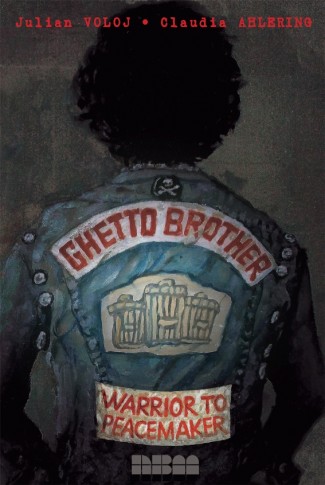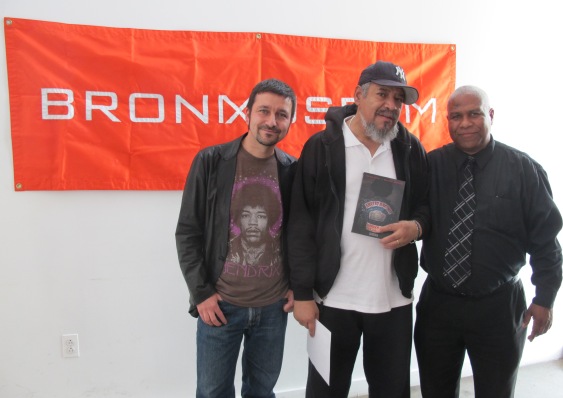
Cover
June 10, 2015 By Kim Brown
Writers Milan Kundera, Stephen King and Sunnysider Julian Voloj all have something in common: they wrote the “Best Summer Books” of 2015, chosen by Publishers Weekly.
Neither the honor, nor the release of Voloj’s graphic novel “Ghetto Brothers” have changed his life much, he said. However, it has increased his appreciation of the fabric of New York.
“I discovered another layer of New York City and became part of a community.”
Not just any community.
He became close with former Bronx gang members, like Benjamin Melendez, founder and leader of the Ghetto Brothers, and met people like Afrika Bambaataa, a DJ who helped spread Hip Hop throughout the world.
Voloj’s book is a fictionalized first-person narrative that traces Melendez’s immigration to the Bronx, his founding of the powerful Ghetto Brothers gang and the eventual brokering of a gang truce in the Bronx.
The legendary Hoe Avenue Peace Meeting in 1971 led to music and dance parties attended by factions from all over the borough; it was at these parties that Hip Hop was born.
“Would Hip Hop have started without Melendez? No one knows. But there is a definite connection between the truce and the start of Hip Hop,” Voloj said.
There is also a definite connection between the Sunnysider and the activist he profiled.
Both are Jewish immigrants to the city and both share a love of music.
“Hip Hop was something original done from within the community,” Voloj said. “They created something positive when there was nothing there.”
The release of the book has not meant an end to Voloj’s relationship with Melendez.
“We both became friends and still talk regularly,” he said.
Voloj, born in Germany to Colombian parents, met Melendez while working on a photo series about Jewish diversity in 2010.
“I thought, a Puerto Rican Jewish gang leader, sounds like a perfect addition to our series.”
Melendez took him on a tour of the South Bronx neighborhood where he grew up in the 1960s, when the city was on the verge of bankruptcy and crime was rampant. The two got along so well, that despite having a full-time job and two young children, Voloj felt compelled to tell Melendez’s story.
As a child in Germany, Voloj gravitated toward graphic novels and Hip Hop, the music of outsiders. “Hip Hop was minority music. I was the only black-haired kid in school,” he said.
His initial meeting with Melendez led to dozens if not hundreds of others over the next four years, both with Melendez and other former gang members, who are now in their 50s and 60s.
The interviews helped shape the coming-of-age narrative about a young man accepting his identity, and informed illustrator Claudia Ahlering’s time-period drawings of the South Bronx.
Each panel of the novel is infused with details from the time, from broken streetlights to accurate depictions of dartboards and posters on clubhouse walls.
Both the stunning images and unique storyline have contributed to the book being recognized as a Graphic novel pick-of-the-month by Barnes and Noble. Whether the publicity will translate into sales is yet to be determined.
There is, however, renewed interest in Melendez.
“Now that Hip Hop is such a big phenomenon, interest in the back story is there,” Voloj said.
In 2011, Voloj and Melendez organized an event commemorating the 40th anniversary of the Hoe Avenue Peace Summit.
Joseph Mpa, a community organizer who worked with the Black Panthers attended. It was Mpa who convinced Melendez to put an end to gang violence. (Both Mpa and Melendez spent several decades after the truce working as youth counselors.)
A Ghetto Brothers album has recently been re-released and there have been several panel discussions and events honoring the former gang leader turned activist and peacemaker.
A documentary just came out, as well.
While Voloj is now working on his next book, it is Melendez who is getting the attention he hasn’t gotten in a long time.
“His story had been forgotten,” Voloj said, “but now, thanks to the book, he’s getting the recognition he deserves.”
For more information, please click here

Julian Voloj (l.), Benjamin “Benjy” Melendez, activist and former Ghetto Brothers leader (c.), Joseph Mpa, former Black Panther activist (r.)
4 Comments

Glorifying degenerates and a terrorist, terrific
This is a well written Sunnyside Post article.
book pic looks like springsteen ’73!!
Looking forward to this as well as the Rubble Kings movie. I wonder how NYC would look these days if all the old timers in the South Bronx and Harlem complained about “gentrification” and “change” in the neighborhood…